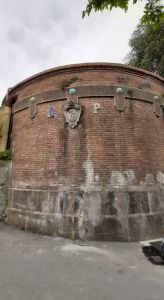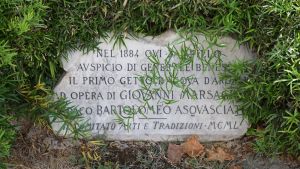The contract, drawn up on 12 July 1883 between the town council and the Marsaglia company, was based on the following points: the municipality granted the entrepreneur the exclusive right to occupy public land free of charge for the construction of the drinking water pipeline; the duration of this concession was eighty years, after which the aqueduct would become the property of the town; the entrepreneur had to guarantee the purity of the water, which the council was entitled to have analysed periodically; the water was to be drawn for 4. 000 cubic metres per day from the springs at the foot of Monte Ceppo and subsequently for a further 3. 500 cubic metres from the Ossentina torrent; the Town Council allowed 200 cubic metres of water not included in the calculation to be taken to Ospedaletti; the surplus water was to be used for industrial and agricultural purposes at reduced prices; 1,000 cubic metres per day were to be allocated to the Town Council for the hygiene needs of the town; the quantities of water from private subscriptions were to be poured over the course of the day into the collection tanks belonging to the subscribers; the public fountains were to be increased by one per thousand inhabitants. The aqueduct was inaugurated on 12 March 1884. The springs that fed it came from an average altitude of 900 metres above sea level. It was hermetically sealed and built partly of stone and concrete and partly of cast iron. It crossed the Oxentina and Armea valleys and had a total length of 25 kilometres, much of which was covered by water under forced pressure.
The aqueduct was inaugurated on 12 March 1884. The springs that fed it came from an average altitude of 900 metres above sea level. It was hermetically sealed and built partly of stone and concrete and partly of cast iron. It crossed the Oxentina and Armea valleys and had a total length of 25 kilometres, much of which was covered by water under forced pressure.
In Poggio, there was a first large collection tank called "del Poggio" and a second one called "degli archi", built along the San Romolo mule track.
At Argallo there was a pump that raised the water from the springs depressed with respect to the pipeline. This was a great achievement of hydraulic engineering, carried out with the best materials and the most advanced technology.
« The Asquasciati with the Argallo aqueduct, built by the engineer Giovanni Marsaglia, provided San Remo with a healthy and abundant irrigation. (A.N.Brizio. "Au Pays du Soleil". History of Sanremo. 54° - 4 ») . Near the fountain, known as the "Zampillo", a plaque was placed in 1950 to recall how, « in 1884, thanks to the merits of Marsaglia and Mayor Asquasciati, water from Argallo "gushed" for the first time ».
Near the fountain, known as the "Zampillo", a plaque was placed in 1950 to recall how, « in 1884, thanks to the merits of Marsaglia and Mayor Asquasciati, water from Argallo "gushed" for the first time ».
The construction of the aqueduct implied a considerable burden for the town, but the town council did not hesitate to decide on it and even pressured for a quick completion. An increased water supply was necessary to solve the hygiene issue and sufficient water had to be supplied to the foreign colony if it was to establish itself as an international health resort. The problem of costs was thus overshadowed, and tourism, now the city's main source of wealth, could not be neglected.
But it was not enough for the town hall to finally build the aqueduct, the municipal authorities wanted above all to link San Remo to a symbol and demanded a grandiose pipeline, capable of attracting the attention of the Riviera's tourist clientele.
The contract envisaged an aqueduct capable of delivering 7,500 cubic metres of water per day, something like 90 litres per second and 450 litres per inhabitant per day. Nice, the first city in France, boasted 300 litres per inhabitant per day, Paris 90, Berlin 54 and London 141. In Italy Genoa had 120 litres, Livorno 27 and Lucca 24. With the construction of the aqueduct San Remo became one of the best supplied European towns in the 19th century.
Of this great quantity of water, as said, one thousand cubic metres per day belonged to the Municipality, to supply the public fountains and the wash-houses (at the end of the century there were thirty of the former and three of the latter), to water the streets and to rinse the sewers and the white canals. These tasks, however, absorbed much more than the amount agreed with the concessionaire, reaching almost 1,500 cubic metres, broken down as follows: 500 for the fountains, 500 for the wash-houses and the remaining third for the hygiene of the town, for which the municipality had about 150 watering points at the end of the century.
The municipal authorities were always able to make use of this considerable volume of water, but the total quantity brought by the pipeline to San Remo throughout the 19th century was never more than 7,500 cubic metres per day. In fact, once the water from the Argallo springs arrived in the city, in the amount of 4,000 cubic metres, all the needs were met and there were large surpluses. The Municipality therefore did not proceed with the request to exploit the waters of the Ossentina and the concessionaire considered himself relieved of the obligation to supply the agreed 7,500 cubic metres.
But if the municipal authorities remained inactive, the same was not true of the Marsaglia company, which purchased the springs that fed the Ossentina and fed them into the aqueduct, but exploited the new volume of water to the advantage of Porto Maurizio, which was connected by a branch that supplied 800 cubic metres a day. Sanremo claimed the new quantity of water for itself and asked the concessionaire, now that the waters of the Ossentina were available, to meet the agreed supply of 7,500 cubic metres. The result was an interminable dispute that went from the Sanremo tribunal to the Genoa Court of Appeal and the Turin Court of Cassation.
What prompted the municipality's dispute with the Marsaglia company was, unbelievably, the problem of the water shortage which, only ten years after the aqueduct was put into operation, was recurring.
The fact is that not only was the city not using the 7,500 cubic metres originally agreed, but it was also not using the 4,000 cubic metres from the Argallo springs. In fact, the Argallo springs had a capacity of less than the calculated 50 litres per second during the summer season. In the 1990s, the municipality absorbed about 1,500 cubic metres for public needs and about 1,000 cubic metres were absorbed by private subscriptions. This resulted in a minimum consumption of around 2,500 cubic metres, which was often barely met in summer, especially when it did not rain for long months. In short, the city, which should have had one of the first aqueducts in Europe in proportion to its population, could hardly meet the needs of its users and was in serious difficulty when faced with requests for new subscriptions.
The problem, especially if projected into the future, was so serious that it could not even be solved by recovering the 800 cubic metres of water allocated by the concessionaire to Porto Maurizio. It was imperative to obtain all the available springs at the Ceppo aqueduct in order to significantly increase the capacity of the aqueduct.
It was possible to do both, and in the new century the water supply problem was finally solved. The pipeline, which after yet another dispute with the Marsaglia company was municipalised, was put in a position to work at its maximum flow rate, which was 9,000 cubic metres in the «free surface» section leading to the Poggio reservoir and 6,500 cubic metres per day in the «high pressure» section leading to the "archi" reservoir.
At the end of the first decade of the 20th century, the maximum supply of the springs administered by the municipality amounted to 9,000 cubic metres per 24 hours, while the minimum volume of water obtained in summer was 4,500 cubic metres. However, this latter quantity could be increased by 1,000 cubic metres by piping water from two reserve springs, Argenta and Lauretta, located near Vignai. Meanwhile, the demand for drinking water was increasing.
In 1906 there were 1,525 subscribers, with a daily consumption of 1,720 cubic metres; in 1909 there were 1,697 subscribers, with a daily consumption of 2,120 cubic metres. These figures did not include Ospedaletti's commission (200 cubic metres), nor did they include the amount consumed by the municipality for public services (1,500 cubic metres) or to start up the turbines of the municipal electric plant (1,500 cubic metres).
AQUEDUCTS - Aqueduct Giovanni Marsaglia
Article Index
Page 3 of 5




